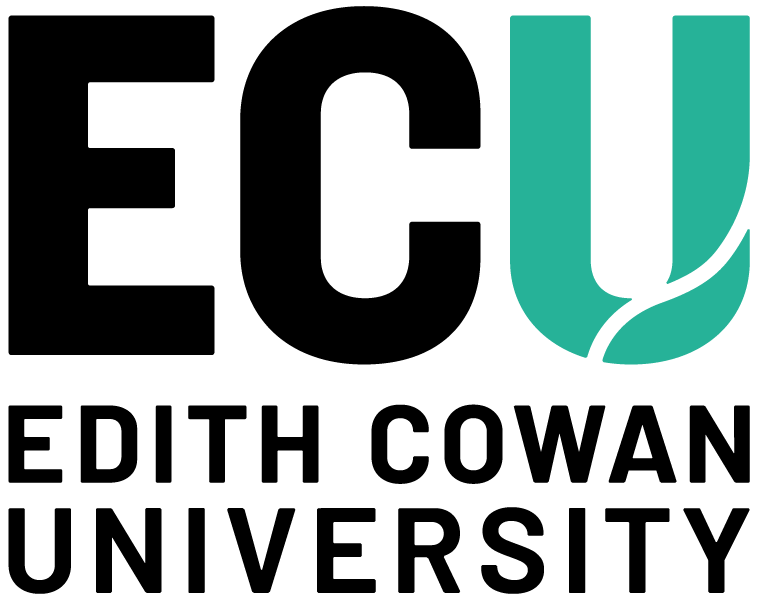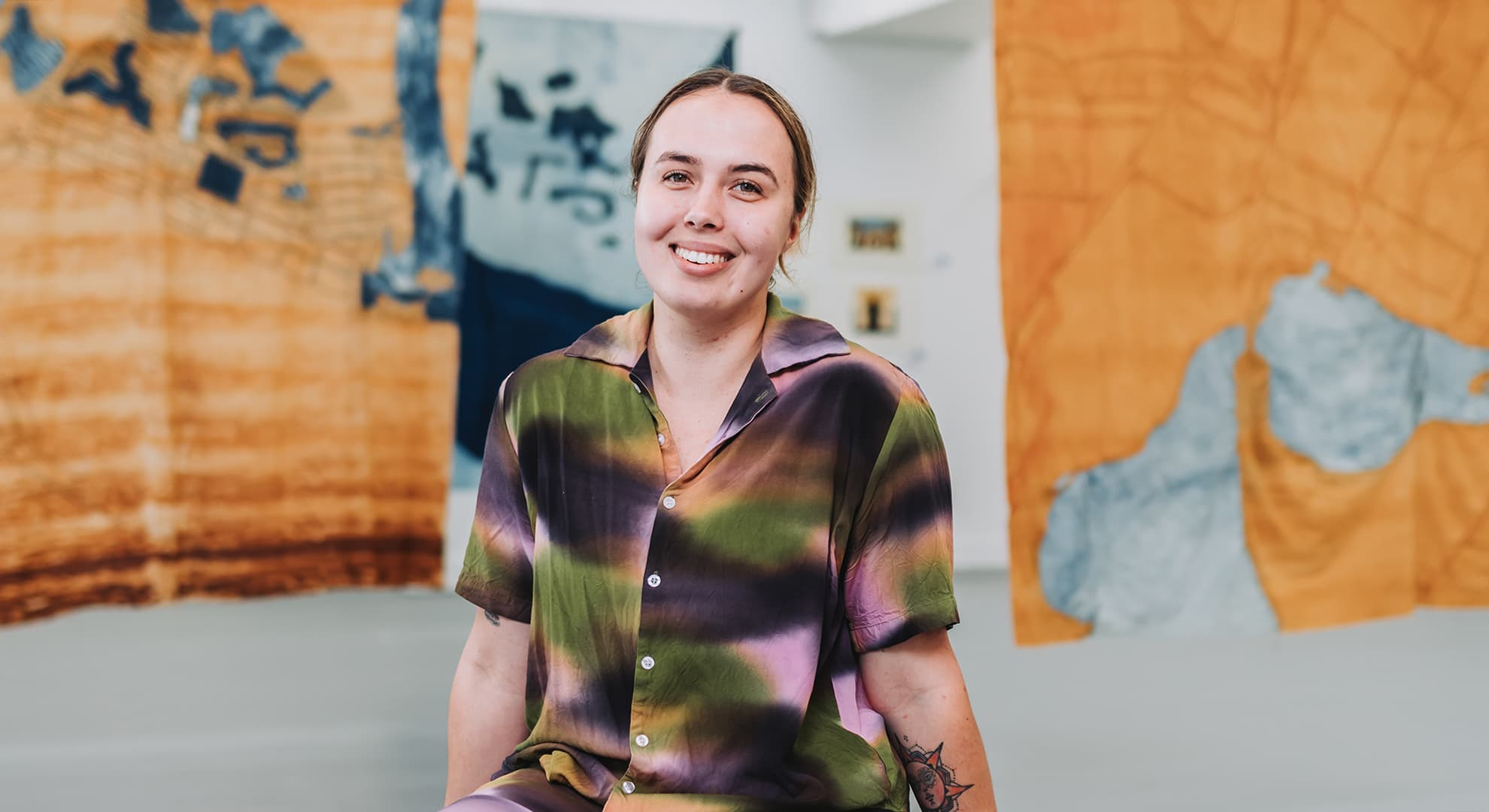The Boola Moorditj Boordiya (Many Strong Leaders) exhibition is open to the public from 18 June - 17 July 2024 at ECU's Gallery25 on the Mount Lawley Campus.
Drawing from the ECU Art Collection, the exhibition is a key program for its Gallery 25 and Kurongkurl Katitjin and the highlight on the University’s 2024 NAIDOC Week calendar.
Boola Moorditj Boordiya (Many Strong Leaders) showcases artworks from Noongar artists: Tjyllyungoo Lance CHADD | Parnell DEMPSTER | Peter FARMER | Sandra HILL | Dianne JONES | Bella KELLY | Norma MACDONALD | Marribank CO-OP | Gillian MILLER RILEY | D NINYETTE | Meeyakba Shane PICKETT | Ben PUSHMAN | Jean RILEY | Lesley RILEY | Wanda RILEY | Clifford RYDER
 Gillian Miller-Riley, Untitled (Vase/ Basket), 1998. natural fibres, fabric and emu feathers. Edith Cowen University Art Collection, A2224. Photography Dan McCabe @artdoc_au
Gillian Miller-Riley, Untitled (Vase/ Basket), 1998. natural fibres, fabric and emu feathers. Edith Cowen University Art Collection, A2224. Photography Dan McCabe @artdoc_au
ECU's inaugural Lead, Cultural Strategy and Development Clothilde Bullen, herself an acclaimed Wardandi and Badimaya, curator, writer and advocate, said this exhibition proudly shares the University’s unique collection in an apt celebration of this year’s NAIDOC Week theme 'Keep the Fire Burning! Blak, Loud and Proud.'
"Art has the transformative power to inspire, educate and engage," said Clothilde.
"And here ECU has a role and an opportunity to open a cultural space to talk about cutting-edge, immersive and meaningful First Nations' narratives that not only honour Noongar elders, leaders and ancestors but engage and educate new audiences."
"We are delighted that Boola Moorditj Boordiya (Many Strong Leaders) could be curated by Zali Morgan, who is a Whadjuk, Ballardong and Wilman Noongar woman, a multidisciplinary artist and writer currently based in Boorloo."
Zali has a deep passion for working with Aboriginal and Torres Strait Islander art and artists, particularly Noongar art and artists. She has worked closely with private and institutional collections, with a keen interest in decolonising practices. Zali’s practice spans Curating, Creative Writing, printmaking and sculpture.
In her printmaking, Zali looks at iconic buildings and spaces within Boorloo and the Noongar region and attempts to expose the history and significance of the sites for Noongar people.
Boola Moorditj Boordiya (Many Strong Leaders) Curatorial Statement by Zali Morgan
Noongar creative expression has been practised in a multitude of ways since the Nyitting times (the cold times, the beginning of the world as we know it). Whether it is dance, oral storytelling, or mark-making, different modes of cultural expression have been passed down from generation to generation, from parent to child, from boordiya (boss) to koolangka (children).
Boola Moordijt Boordiya (many strong leaders) is a space that reveres the knowledge holders, survivors, and influential Noongar artists. These trailblazers have not only led the way but shattered expectations, paving paths and framing expectations for what audiences now anticipate from Noongar artists.
This exhibition brings together renowned artists Sandra Hill, Meeyakba Shane Pickett (dec.), and Tjyllyungoo Lance Chadd, who have made some of the most significant contributions to the contemporary acknowledgment of Noongar art.
They are joined by a new generation of artists, including Ben Pushman, Peter Farmer, and Dianne Jones, who continue to carry the torch of Noongar art. Drawing from the Edith Cowan University Art Collection, Boola Moordijt Boordiya presents a journey through time. It showcases a unique collection of works; each a window into a different era, a different story, and a different expression of Noongar art. However, each work was not created in isolation.
Many artists have been influenced by previous generations, adapting and recreating with their own knowledge. The breadth of the time in which the works were created is a testament to the enduring nature of Noongar art.
A particularly poignant part of the historical narrative of Noongar art practice is the story of the Carrolup Native Settlement. Located in the south-west of Western Australia, Carrolup was an institution where Aboriginal children were taken from their families and placed under the guise of being educated, with the goal to be ‘assimilated’ into the western society of the time.
During Mr Noel White's tenure from 1946 until the Carrolup Native Settlement school’s closure in 1951, the school became a symbol of resistance. Mr White encouraged the children to depict their experiences at the Settlement through art, leading to what is now recognised as the Carrolup Child Art Movement.
The Department of Native Affairs disapproved of Mr White's approach with the detained children, particularly after their artwork gained attention at various agricultural shows. Philanthropist Florence Rutter took notice of the art, helping to bring it to international prominence.
Mr White's defiance in preserving the children's cultural expressions ensured their legacy endured. The art of Carrolup holds a significant place in history, both for Noongar people and for wider Western Australia. It represents resilience and the enduring spirit of the Aboriginal people, but also speaks to the idea of our shared histories and place, the truth of which cannot go unchallenged.
Both Clifford Ryder and Parnell Dempster were part of this movement at Carrolup as young people. With their works (and those of other children at the settlement) collected internationally, Ryder and Dempster’s works in the exhibition present a powerful reminder of the strength of cultural identity and artistic expression, even in the face of adversity.
Working in styles similar to the Carrolup children, Bella Kelly, Wardandi and Minang woman and a mother to children at the Carrolup school, her artistic legacy is deeply rooted in her evocative landscape paintings.
The works are timeless tributes to the rugged beauty and tranquil expanses of the majestic Stirling Ranges, a prominent feature in many of her artworks. Dominated by the imposing presence of Bluff Knoll, the highest peak in the range, Bella’s paintings capture the range’s grandeur with a profound sense of intimacy and familiarity.
Bella Kelly's legacy endures not only as an accomplished artist but as a cultural ambassador whose works preserve and honour the rich heritage of the Great Southern for generations to come. Meeyakba Shane Pickett expressed his deep passion and love for boodjar (Country) through his paintings.
In his early works, he was inspired by the Carrolup Native Settlement and the works of the late Albert Namatjira, particularly in his use of vibrant colour to depict Country. During the final decade of his career, Pickett adopted a more abstract approach.
His figurative landscapes balance expressive and painterly qualities with precise details. His later works evolved into pure abstraction, conveying a sense of place through the elemental aspects of the land. Despite this shift towards abstraction, the sophistication of his landscapes persisted.
Shane Pickett remains an artistic inspiration and acknowledged leader in the Noongar community for how his practice evolved and, with it, the appreciation from wider Australia and indeed internationally for the work of Aboriginal artists from the southwest of Western Australia.
Boola Moordijt Boordiya (many strong leaders) pays homage to the ancestors, elders, and leaders who played pivotal roles in the contemporary revival and advancement of Noongar art.
These artists and knowledge holders have shared their profound insight and expertise through rich traditions such as storytelling, song, dance, and ceremonial practices. Through their creative expressions, the artists in the exhibition honour these ancestral influences and ensure that Noongar art (and artists) remain vibrant and relevant.
Community Events
We encourage you to attend NAIDOC Week events in your local community and embrace a greater connection to the country on which we live. Visit NAIDOC Week and your local council website for a list of events happening near you.
Get involved on social media
Show your support on socials with the #NAIDOC2024 #NAIDOCWeek and #BlakLoudProud hashtags and tag the official NAIDOC page on Facebook, X or Instagram.
ECU Event details
Perth Metro:
Boola Moorditj Boordiya (Many Strong Leaders)
18 June-17 JulyGallery25, ECU Galleries, Building 10,
ECU Mount Lawley
(Exhibition open to the public)
View exhibition anytime during gallery hours
In-Conversation with Noongar Artists & Curators
Panel discussion led by curator Zali Morgan, with Noongar artists: Peter Farmer Snr, Amanda Bell, Brett Nannup, and Emily Rose.
Saturday, 13 July from 2pm-3pm
Gallery25, ECU Galleries, Building 10,
ECU Mount Lawley
(Event open to the public)
Event details and registration
South West:
Celebrating NAIDOC Week and Launch of First Nations Artwork in Student Hub
Tuesday, 9 July from 11.30am-12.30pm
Building 1 Gallery and Foyer, followed by tour of Student Hub
ECU South West
(Event open for staff and students only)
Event details and registration
With support from Kurongkurl Katitjin, ECU Art Collection and School of Arts & Humanities.

 Exhibition Curator, Zali Morgan. Photo: Richard Van Wyk
Exhibition Curator, Zali Morgan. Photo: Richard Van Wyk


